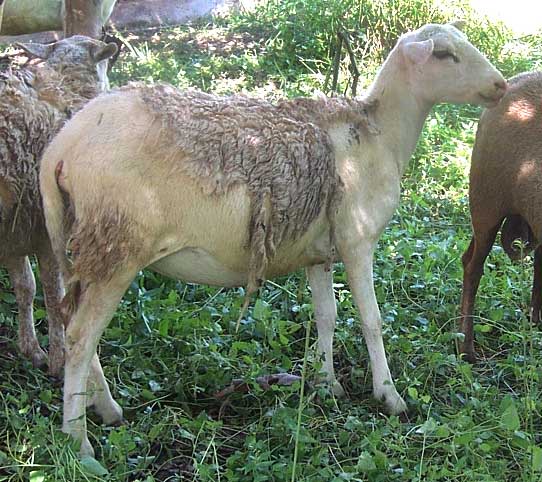Excerpts from Jim Conrad's
Naturalist Newsletter

from the September 7, 2007 Newsletter issued from Sierra Gorda Biosphere Reserve Headquarters in Jalpan, Querétaro, MÉXICO
KATAHDIN SHEEP
On the road to the market a fellow keeps sheep in a grassy fenced-in area. Most days I pause a while to see how the critters are doing. One of the sheep is shown above.
That particular sheep interested me because she was shedding. I think of sheep as producing wool, which has to be sheared. Yet this sheep's wool was matting and falling off on its own. Was this a self-shearing sheep, where the owner only had to pick up the wool from the ground before selling it?
A bit of search-engine work suggested that the sheep in the photograph may be the Katahdin breed, famous for their fleece falling off without shearing, for the sheep's tolerance to intestinal worms, for being very adaptable and low-maintenance, and for twins usually being born. Apparently the fleece isn't of good enough quality to be sold. Katahdins are raised to be eaten, and that sounds right for here since there's no wool- weaving tradition in these mountains, but there are plenty of roadside establishments selling wood-fire-smoked, "ranchero"-style mutton.
You can see if you agree with my breed-identification. While researching the breed I came across a fine website serving as a sheep identification field-guide. It's at http://www.sheep101.info/breeds.html.
That site informs us that "There are more breeds of sheep than breeds of any other livestock species. Worldwide, there are more than a thousand distinct sheep breeds, more than 40 in the United States alone."
Browsing that site I realized that sheep farming is another of those subjects that at first seems simple and direct, but in fact is very complex and marked by remarkable diversity. Just choose some of the breed- links at the above page and read about their special qualities.
From what I can see, the words "wool" and "fleece" can be used interchangeably. The word "polled" means "having no horns."